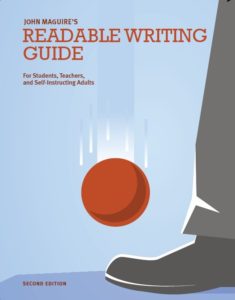That American students and college graduates write lousy prose is not disputable. The Chronicle of Higher Education runs op-eds about it all the time. The Washington Post published at least three big blog posts on the subject in 2017. The New York Times ran a well-reported 2,000-word story by Dana Goldstein called “Why Kids Can’t Write.” However, the headline we’d like to see (“Business Owners Say College Grads Writing More Lucidly Than Ever”) will appear only in The Onion.
The concerned feature stories are symptomatic and correct, as far as they go, but they leave out the scale of the problem, the causes of the problem, and likely solutions.
The scale of the problem is huge. About 3.1 million freshmen will enter American colleges this fall, according to the National Center for Education Statistics. All these 3.1 million will take some kind of first year writing course, even if it’s remedial. The average football stadium holds about 70,000 fans, which means this fall’s incoming freshmen will fill about 44 football stadiums. They will all be taking writing courses.
Their instructors (figuring 20 students per section) will be an army of 77,500 teachers Most will be adjuncts, and if you packed them into their own football stadium, they’d fill every seat. Let’s get that camera image clear: a large football stadium packed absolutely fill with adult women and men, and every seat is occupied by someone teaching freshman comp this fall, and most of them must be fairly ineffective at teaching students to write. Otherwise we wouldn’t have all those headlines to read.
The causes of poor writing instruction are several, including (1) the students are poorly prepared in high school, (2) most of the teachers are poorly paid part-timers, (3) many teachers are grad students with no teaching experience and (4) the field of Rhetoric and Composition is slow-moving, committed to ineffective methods and suspicious of new ideas.
The most scandalous fact—and the newspaper reporters miss this—is that the power structure in Rhetoric and Composition is no longer interested in teaching writing. Phillip Mink, an assistant professor in the English Department at the University of Delaware, wrote me an email last year and said:
The college writing profession has made a conscious decision not to teach style… If you review the scholarly literature, which I have done, you will find virtually nothing about student prose at all. [To these people] the quality of student prose is nothing more than an afterthought.
Outside the power structure, we have the adjuncts, who do most of the instruction, and many are trying to teach writing and are not bad at it. But the power structure in the field—those on tenure tracks with PhDs—if Dr. Mink is right—have conveniently defined composition to exclude instruction in prose style. The adjuncts, the untouchables in this caste system, do the labor of trying to teach writing. The Brahmins way above them teach things slightly related to writing, such as how writing, images and ideas create impact and circulate to address the issues facing our communities. The Brahmins set the official standards, and they stay clear of teaching students how to write readable sentences.
Evidence that the power structure in composition actually killed the teaching of sentences as a serious effort comes from Robert J. Connors’s “The Erasure of the Sentence.” Connors pointedly quotes professor James Moffett as saying, “It’s about time the sentence was put in its place”
The infection of college writing with social-justice activism is another problem, and not a small trend, according to George Gopen, emeritus professor at Duke University and author of Expectations: Teaching Writing from the Reader’s Perspective (2004). Dr. Gopen insists that writing is about clear communication to the reader. That’s the common-sense understanding, but it’s out of favor among the Brahmins and Dr. Gopen stands mostly alone. When he’s asked what would turn American college writing around, he says, “Stop teaching social ethics and start teaching writing.”
The best likely solution would be direct instruction in the classic English plain style, the sentence style that serves the reader best. It would require a revolution for a college writing profession that now barely attends to the reader.
Imagine those 44 stadiums full of freshmen writers—all colors and sizes from all over the country—perhaps eager to learn. They will learn something in comp, but not much about how to be clear or interesting to a reader. Few of their teachers will have stressed the key questions that professional editors raise all the time: How will the reader understand this? Will this confuse your reader? Can you simplify this so the reader gets it right away?
To make the turnaround, we could do worse than return to the original guru of reader service, the late Rudolf Flesch, author of The Art of Readable Writing (1949). He invented the concept of readability scoring, and though it’s been degraded to a bit of a joke by computerized word-counting, it still has a lot of value. If we adjusted his ideas of readability a little bit, they would make a great backbone for a new type of college writing course. We really need tightly focused training in creating readable prose. It can be done, and students would benefit hugely from having a single and practical target to hit: being readable and interesting writers.
- The Flesch approach is practical. It uses objective numerical standards as guides to the prose quality, such as average sentence length, and other word ratios. Students can adjust their behavior and gain control over their writing. They gain in self-efficacy.
- The Flesch approach lends itself to staging from simpler skills to more difficult—something needed with today’s poorly prepared students.
- Finally, contrary to repeated arguments from academics, the readability approach covers a wide range of readable styles, not the short-sentence style as Flesch’s detractors claimed. Rudolf Flesch in fact argued strongly against using his insights to write at a primer-level See Spot run style.
One commenter on the Times article “Why Kids Can’t Write” made the interesting point that writing teachers decline to do what coaches do, which is run drills on the fundamentals, even though anyone who watches a well-played football game knows that’s what works.
That same student that you hope is absorbing good writing through reading, or whose voice you don’t want to stifle, goes after school to sports practice, where they drill for hours to be ready for the game. The coaches don’t merely show students films of great plays, nor are they afraid that their kids can’t be creative. They understand that without control of fundamentals, talent is wasted.
The fundamentals of written communication are sentence handling and being clear for the reader. A sequenced skill course in readable writing, if widely adopted, would begin to repair the huge mess that college writing now is.



Leave a Reply